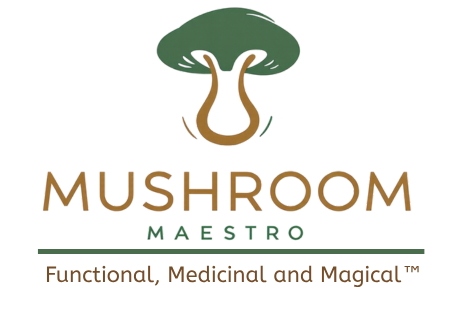In a fast-paced world dominated by high stress, demanding schedules, and chronic fatigue, the search for sustainable, natural solutions to boost energy has become more urgent than ever. While caffeine and sugar-laden quick fixes still dominate morning routines and mid-afternoon slumps, there is growing awareness of the long-term impact of diet on mental clarity, physical stamina, and overall vitality. Within this conversation, a powerful class of foods known as adaptogens has emerged, offering promising solutions for people struggling with exhaustion, burnout, and low energy. These botanical substances, derived mostly from herbs and mushrooms, are celebrated for their ability to help the body resist stress and restore balance. Interestingly, many of these adaptogens are also considered the best food for tiredness, offering both immediate relief and long-term support by enhancing the body’s resilience and stabilizing energy levels.
What sets adaptogens apart is not just their capacity to manage stress but their unique synergy with nutritional science. They often contain compounds that influence the hypothalamic-pituitary-adrenal (HPA) axis, regulate cortisol, and support mitochondrial function—factors central to energy production and fatigue reduction. Moreover, these foods are increasingly backed by clinical research and traditional medicine alike. The result is a growing repository of evidence-based insights that show how certain adaptogens can be incorporated into the diet not just for stress relief but to effectively combat both physical and mental tiredness. This article dives deep into these nutritional powerhouses, revealing how they serve as expert-recommended interventions for those seeking the best diet for energy, resilience, and long-term vitality.
You may also like: Unlock Powerful Stress-Relief with Adaptogenic Mushrooms and Stamina Herbal Support
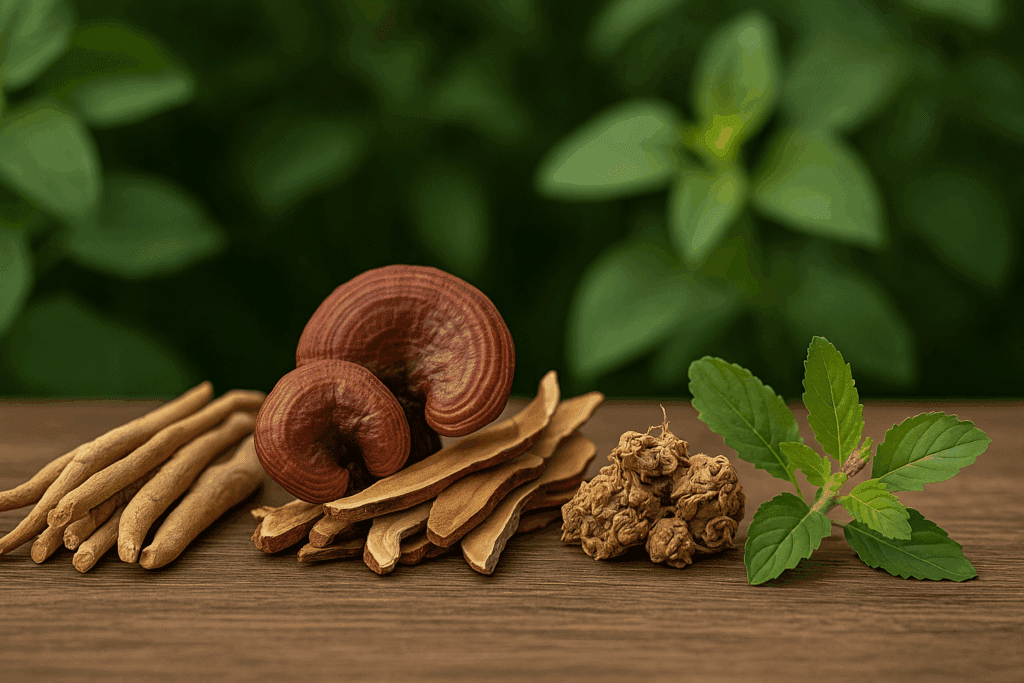
Understanding Adaptogens: Nature’s Balancing Agents
Adaptogens are natural substances found primarily in herbs and mushrooms that help the body cope with physical, emotional, and environmental stressors. Their unique action lies in their ability to modulate the body’s stress response—particularly through the endocrine and nervous systems—without overcorrecting or causing dependence. This bidirectional effect allows adaptogens to bring the body back to homeostasis, regardless of whether stress levels are too high or too low. First coined in the mid-20th century by Soviet scientist Dr. Nikolai Lazarev, the concept of adaptogens has since gained traction globally, integrating itself into both Eastern herbal traditions and Western nutritional paradigms.
In the realm of fatigue, adaptogens offer particular promise. Unlike stimulants that offer temporary boosts followed by crashes, adaptogens work gradually and sustainably. They do not simply mask symptoms of exhaustion; rather, they support the body’s natural energy regulation by influencing key physiological systems. Many adaptogens enhance mitochondrial energy output, reduce inflammation, and even regulate circadian rhythms—all factors intricately linked with chronic tiredness. This aligns them closely with the concept of a high energy diet, one that not only fuels the body but fortifies it against wear and tear.
As such, incorporating adaptogens into one’s lifestyle is more than just a trend—it represents a strategic, science-backed shift toward using food as medicine. The foods we’ll explore in this article double as stress relievers and energy enhancers, forming a critical part of a diet to fight fatigue and boost stamina naturally.
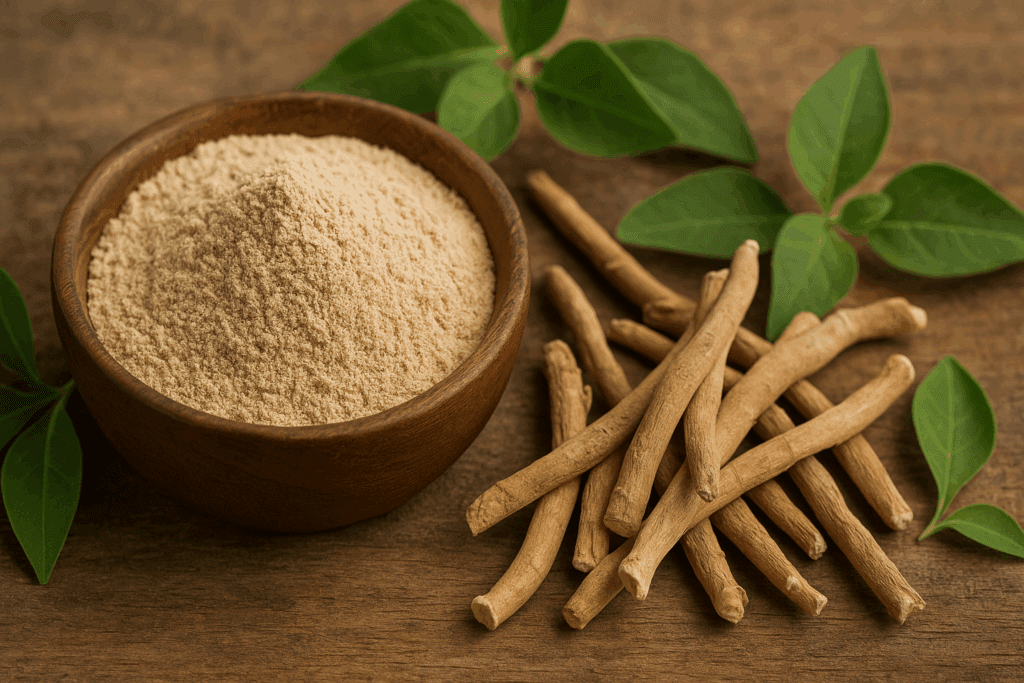
Ashwagandha: The Cortisol-Calming Root That Fights Tiredness
One of the most well-known adaptogens, ashwagandha (Withania somnifera), has been used in Ayurvedic medicine for over 3,000 years. Revered for its rejuvenating properties, ashwagandha is often prescribed to individuals experiencing fatigue, anxiety, and hormonal imbalance. What makes this root a standout in the realm of adaptogenic foods is its profound ability to lower cortisol—the stress hormone responsible for many symptoms of fatigue, sleep disturbances, and energy crashes.
Recent clinical trials have shown that ashwagandha supplementation significantly reduces markers of stress and enhances perceived well-being. In doing so, it indirectly contributes to improved sleep quality and higher morning energy levels. Furthermore, its compounds—called withanolides—appear to modulate the body’s inflammatory response, supporting mitochondrial health and physical endurance. These attributes place ashwagandha squarely among the best foods for fatigue, especially when integrated into smoothies, teas, or health-conscious desserts.
Perhaps what is most compelling about ashwagandha is how seamlessly it fits into the best diet for energy. While caffeine disrupts hormonal rhythms and depletes adrenal reserves over time, ashwagandha builds energy stores gradually by improving the body’s ability to recover and adapt. This makes it not only one of the best food for tiredness but also an essential part of any diet to help fatigue naturally and sustainably.
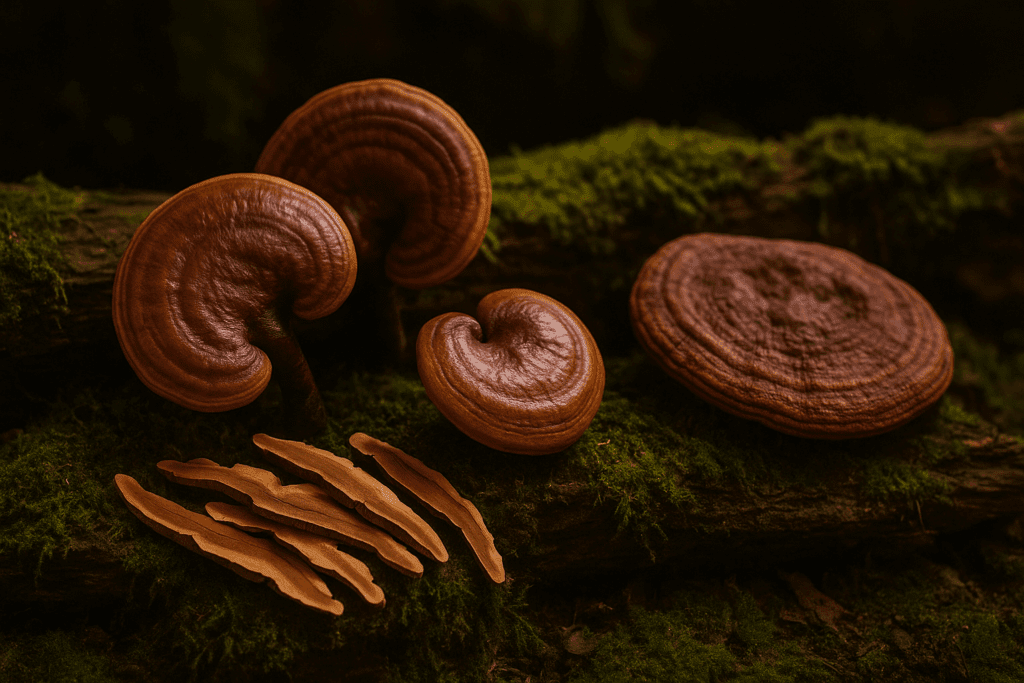
Reishi Mushroom: The Fatigue-Fighting Fungi for Deep Rest and Immune Balance
Among the many adaptogenic mushrooms, reishi (Ganoderma lucidum) stands out for its deep, grounding effects on both the immune system and the nervous system. Traditionally known as the “mushroom of immortality” in Chinese medicine, reishi is renowned for its calming effects, which counteract the overstimulation and nervous exhaustion that often contribute to chronic fatigue. Reishi supports parasympathetic nervous system activity, encouraging deep rest, improved sleep quality, and lowered stress reactivity.
From a biochemical perspective, reishi contains beta-glucans, polysaccharides, and triterpenes—compounds known to support immune function, reduce inflammation, and optimize cellular energy production. In people experiencing burnout or immune-related fatigue, reishi helps recalibrate the system, supporting long-term energy restoration. It is particularly effective for those whose tiredness is rooted in sleep disturbances or immune dysfunction.
Adding reishi into one’s routine can be as simple as mixing reishi powder into a nightly tonic, golden milk latte, or warm herbal tea. Its earthy, slightly bitter profile blends well with calming herbs like chamomile and lavender. Within the broader context of fatigue reducing foods, reishi plays a unique role by facilitating deep rest rather than stimulating wakefulness. Thus, it complements other foods that help with tiredness by addressing one of its most fundamental root causes: disrupted sleep and poor immune resilience.
Rhodiola Rosea: The Arctic Adaptogen That Boosts Mental and Physical Performance
Rhodiola rosea, native to the cold, mountainous regions of Europe and Asia, has been extensively studied for its effects on both mental and physical endurance. Often dubbed the “golden root,” Rhodiola works by influencing neurotransmitters like serotonin and dopamine, which play a crucial role in motivation, mood, and sustained energy. It also enhances oxygen efficiency in the brain and muscles, making it a favorite among athletes and professionals facing high mental demands.
Unlike many stimulants that cause jitteriness or eventual crashes, Rhodiola produces a stable, alert energy that supports focus and stamina throughout the day. It has been shown to improve cognitive function, particularly under conditions of sleep deprivation and chronic stress. This positions it not only as a powerful brain adaptogen but also one of the best foods to eat to fight fatigue in high-demand environments.
From a practical standpoint, Rhodiola can be consumed in capsule form or as a tincture, often combined with other adaptogens for synergistic effects. As part of a high energy diet, it pairs well with whole grains, fatty fish, and nuts—foods that stabilize blood sugar and prevent the kind of energy dips that lead to sluggishness. For individuals asking, “What foods make you tired and sluggish?” the answer often lies in highly processed, sugar-laden meals. Rhodiola, by contrast, offers a model of energy optimization that is both clean and clinically supported.
Cordyceps: Mitochondrial Support and Oxygen Enhancement for Active Lifestyles
Another adaptogenic mushroom worth highlighting is Cordyceps, a parasitic fungus traditionally used in Tibetan and Chinese medicine. Known for its ability to enhance physical stamina and reduce fatigue, Cordyceps has become popular among athletes and those with high physical demands. What sets Cordyceps apart is its role in supporting ATP (adenosine triphosphate) production—the primary energy currency of our cells.
By enhancing mitochondrial efficiency and improving oxygen uptake, Cordyceps increases endurance and helps reduce perceived effort during exercise. This not only supports athletic performance but also provides tangible relief for those experiencing energy crashes or systemic tiredness. Unlike caffeine, which stimulates the central nervous system, Cordyceps enhances energy at the cellular level, providing a clean and sustainable lift that aligns with long-term health goals.
Cordyceps can be consumed as part of medicinal mushroom blends, added to smoothies, or steeped into adaptogenic broths. When combined with other fatigue reducing foods—such as leafy greens, avocados, and complex carbohydrates—it forms part of a holistic strategy for combatting both physical and mental exhaustion. For those exploring what to eat or drink when feeling sleepy, a Cordyceps-infused tonic may be a far more effective and balanced option than sugary energy drinks or excess coffee.
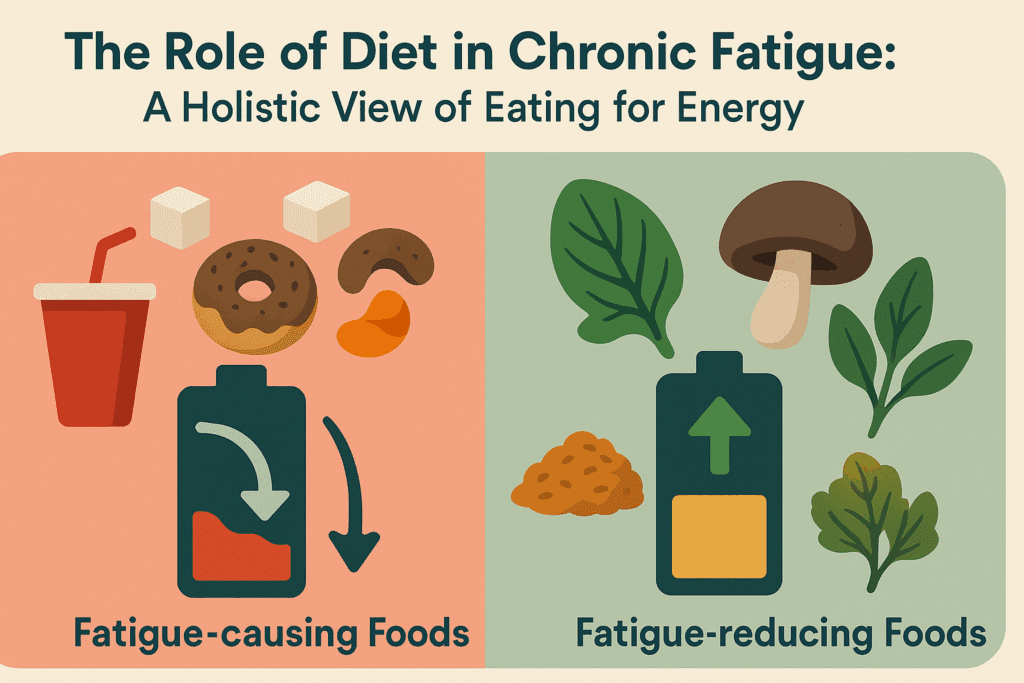
The Role of Diet in Chronic Fatigue: A Holistic View of Eating for Energy
Understanding the relationship between diet and energy is fundamental to reducing fatigue. Chronic tiredness is rarely the result of a single factor; more often, it stems from a complex interplay of nutrient deficiencies, hormonal imbalances, poor sleep, chronic stress, and mitochondrial dysfunction. When we begin to assess what foods help with tiredness, we must take a broader look at dietary patterns that either support or deplete our energy systems. A high energy diet is one that supports blood sugar stability, reduces systemic inflammation, and provides the necessary vitamins, minerals, and phytonutrients for cellular energy production.
In contrast, diets high in refined sugar, saturated fats, and ultra-processed ingredients are the hallmark of foods that cause fatigue. These foods may provide temporary energy spikes, but they are quickly followed by crashes that leave the body in a state of biochemical debt. Such fluctuations can burden the adrenals and exacerbate hormonal imbalances. Consequently, a diet to fight fatigue must emphasize slow-burning carbohydrates, healthy fats, adaptogenic herbs, and complete proteins. When combined with mindful eating habits and hydration, this approach forms a powerful foundation for energy management.
Moreover, chronic fatigue is often accompanied by inflammation and oxidative stress—conditions that certain foods can either worsen or alleviate. Nutrient-dense whole foods rich in antioxidants and adaptogens reduce free radicals and support mitochondrial resilience. This explains why many traditional diets, particularly those rooted in ancestral wisdom, contain components that align with modern understandings of fatigue reducing foods. In this context, the best food for tiredness isn’t just one ingredient or supplement—it’s a lifestyle of nourishment, balance, and thoughtful food choices that fuel both body and mind.
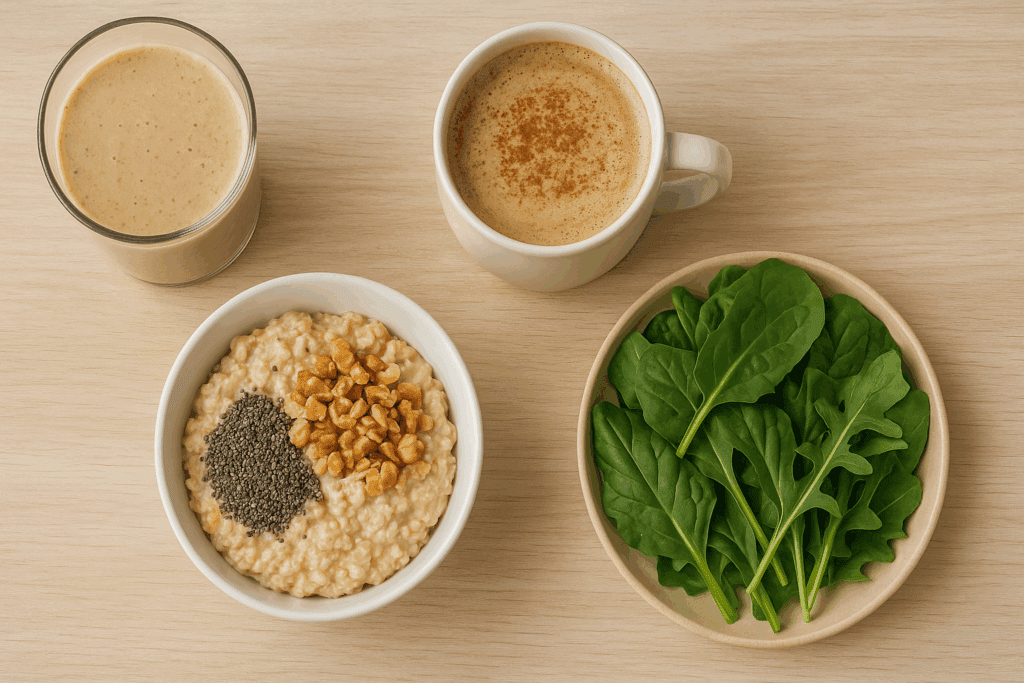
Best Food for Tiredness in Everyday Meals: Functional Ingredients with Adaptogenic Power
Transforming your meals into energy-boosting rituals doesn’t require exotic ingredients or rigid diets. Many of the best foods for fatigue can be found at your local grocery store and easily incorporated into everyday cooking. For example, oats and quinoa are excellent sources of complex carbohydrates with slow release energy, making them ideal for preventing the mid-morning crash. When paired with chia seeds, almond butter, and a sprinkle of maca powder—a powerful adaptogen known for enhancing libido and stamina—you’ve created a breakfast that fuels your brain and body for hours.
Incorporating adaptogenic mushrooms like lion’s mane or chaga into your daily diet can also yield impressive results. These mushrooms support cognitive clarity and immune balance, both of which play indirect yet significant roles in maintaining energy levels. They can be blended into soups, broths, or even morning lattes made with plant-based milk. For lunch or dinner, consider adding sautéed leafy greens, fermented vegetables for gut support, and lean proteins such as wild salmon or tempeh. This combination provides essential amino acids, B vitamins, and anti-inflammatory compounds that combat fatigue at the cellular level.
Smoothies are another excellent vehicle for layering fatigue-fighting nutrition. A blend of bananas, spinach, hemp seeds, coconut water, and an adaptogenic powder like ashwagandha or maca creates a portable meal loaded with vitamins and minerals that prevent energy slumps. It’s not just about what foods make you tired and sluggish—it’s about knowing how to counter them with foods that fuel your body. These practical, nutrient-dense strategies allow adaptogenic foods to become a seamless part of everyday eating, enhancing vitality without relying on artificial energy boosters.
Maca Root: An Andean Energy Tonic for Hormonal and Metabolic Support
Maca (Lepidium meyenii) is a Peruvian root vegetable long revered for its energizing and hormone-balancing effects. Often called “Peruvian ginseng,” maca has been traditionally used to improve stamina, libido, and fertility—attributes closely tied to its impact on endocrine health. Maca works by nourishing the hypothalamus and pituitary glands, which regulate the production of hormones like cortisol, estrogen, and testosterone. These hormonal shifts can directly influence how energetic or fatigued we feel.
Research shows that maca improves exercise performance and increases energy in both men and women. It also supports thyroid health, which is often underdiagnosed in people suffering from chronic fatigue. Because it is a food-based adaptogen, maca offers a unique nutritional profile: it’s rich in fiber, iron, amino acids, and glucosinolates—compounds that support liver detoxification and overall vitality. When included as part of a high energy diet, maca provides sustained fuel without overstimulating the nervous system.
Maca powder can be easily mixed into smoothies, oatmeal, and even baked goods. Its malty, nutty flavor complements both sweet and savory recipes. For those wondering what to eat when you feel weak or rundown, maca offers a nutrient-dense and energizing solution. As with other adaptogens, consistency is key. Daily consumption over several weeks tends to yield the best results, making maca a valuable tool in a long-term strategy to fight exhaustion and improve hormonal balance.

Holy Basil (Tulsi): The Sacred Leaf That Soothes Adrenals and Sharpens Focus
Holy basil, also known as Tulsi, holds a sacred place in Ayurvedic medicine for its calming yet invigorating properties. Unlike traditional stimulants that spike cortisol and heart rate, Tulsi works by soothing the adrenal glands, enhancing resilience without causing fatigue later in the day. This dual action makes it one of the most effective adaptogens for individuals experiencing both physical and emotional exhaustion. Holy basil contains compounds such as eugenol and ursolic acid, which have been shown to modulate inflammatory pathways and improve cognitive clarity.
What makes Tulsi unique among fatigue reducing foods is its ability to calm the mind while simultaneously boosting alertness. This makes it ideal for those suffering from stress-induced tiredness, anxiety, or sleep disturbances. Tulsi also supports detoxification by enhancing liver function, which in turn improves metabolic efficiency—a key factor in sustained energy production. Regular consumption of Tulsi tea or extract can help stabilize mood, improve focus, and reduce brain fog, making it an invaluable ally in any diet to help fatigue.
Culinarily, Tulsi can be consumed as a tea, tincture, or incorporated into herbal infusions. Pairing it with adaptogens like Rhodiola or Schisandra can amplify its effects. For people exploring foods to fight tiredness, Tulsi offers a gentle yet powerful support system. It fits seamlessly into a stress-relief protocol while aligning with the nutritional goals of a best diet for energy. In a world where overstimulation is the norm, Tulsi invites us to restore balance—gently, consistently, and effectively.
Schisandra Berry: The Five-Flavor Fruit That Enhances Endurance and Liver Function
Schisandra chinensis, commonly known as the five-flavor fruit, is a berry used in traditional Chinese medicine for centuries. It derives its name from the complex taste profile that combines sweet, sour, salty, bitter, and pungent elements—each corresponding to one of the body’s five elemental organs in Chinese theory. From a Western nutritional standpoint, Schisandra is valued for its ability to improve endurance, mental performance, and liver detoxification. These attributes make it a formidable component of any fatigue-reducing regimen.
Schisandra’s unique lignans and antioxidants help protect mitochondria—the energy-producing centers of our cells—against oxidative damage. It also increases the body’s capacity to handle stress by regulating cortisol and balancing blood sugar levels. These factors make it one of the best foods to prevent tiredness, especially in individuals exposed to chronic stress or environmental toxins. Additionally, its hepatoprotective properties support liver function, which is crucial for metabolizing nutrients and eliminating fatigue-inducing byproducts.
While not commonly found in Western grocery stores, Schisandra is widely available in powdered form, capsules, or herbal elixirs. It blends well with teas and tonics aimed at boosting energy and mental clarity. For those experimenting with what to eat when you feel weak and tired, a Schisandra blend may offer both immediate and long-term relief. It underscores the principle that foods that reduce tiredness can also taste vibrant and support multiple organ systems simultaneously.
Strategic Adaptogenic Pairings: Creating Synergy in Your Diet to Help Fatigue
One of the most effective strategies in building a high energy diet is combining adaptogens in synergistic ways. While each adaptogen has its unique properties, their effects can be amplified when paired thoughtfully, producing compounding benefits across hormonal, metabolic, and cognitive systems. For instance, pairing ashwagandha with Rhodiola blends the former’s cortisol-regulating benefits with the latter’s focus-enhancing effects, creating a more comprehensive support system for both mental and physical fatigue. Such combinations are particularly effective in individuals experiencing burnout, where multiple bodily systems are under duress simultaneously.
Likewise, combining reishi with Schisandra can promote deep rest while also supporting liver detoxification and cellular repair. This pairing is ideal for those with stress-related sleep issues or for individuals recovering from long periods of overwork or illness. Maca, when used alongside cordyceps, creates an energizing tonic that supports both hormone balance and ATP production, making it one of the best combinations for those seeking foods that make you alert without the crash associated with stimulants. The key to successful pairing lies not only in the biochemical properties of each adaptogen but also in their functional outcomes: mood stabilization, reduced inflammation, better sleep, and sustained energy.
Incorporating these combinations into meals or beverages ensures that your dietary approach to fatigue is holistic, covering both short-term needs and long-term resilience. Adaptogenic pairings allow the user to tailor their fatigue-fighting regimen to their specific needs—whether it’s brain fog, hormonal imbalances, or metabolic stagnation. When consistently applied, these synergistic approaches can transform the diet from merely nutritious to profoundly therapeutic, offering a layered defense against both acute and chronic tiredness.
Timing Matters: When to Eat for Optimal Energy and Reduced Tiredness
Beyond what we eat, when we eat plays a critical role in energy regulation. The body’s circadian rhythms influence hormone levels, digestion, and metabolic rate, meaning that meal timing can either enhance or deplete our vitality. Skipping breakfast or eating too close to bedtime can disrupt cortisol rhythms, impair blood sugar regulation, and contribute to insomnia or morning sluggishness. Conversely, aligning meals with the body’s natural energy cycles enhances nutrient absorption and supports hormonal balance—two pillars of fatigue management.
A well-balanced breakfast that includes foods with slow release energy such as oats, eggs, and berries, paired with an adaptogenic tonic, can set the tone for steady energy throughout the day. Midday meals should focus on light, protein-rich combinations—such as grilled salmon with quinoa and leafy greens—alongside a Rhodiola-infused tea to sustain concentration. Dinner should prioritize relaxation and digestion; foods like sweet potatoes, steamed vegetables, and a reishi or Tulsi infusion can help initiate the parasympathetic response needed for restorative sleep.
Equally important is timing adaptogen intake. While energizing adaptogens like cordyceps and maca are best consumed in the morning or before physical activity, calming adaptogens such as ashwagandha and reishi are more effective in the evening. Understanding these rhythms and applying them intelligently can magnify the benefits of a fatigue-fighting diet. Strategic meal timing, when combined with fatigue reducing foods, becomes a powerful tool to enhance vitality, regulate mood, and reduce the dips that make us reach for caffeine or sugar.
Foods to Avoid: Understanding What Foods Make You Tired and Sluggish
While we often focus on foods that help with fatigue, it’s equally vital to be aware of foods that cause fatigue. Certain ingredients and dietary patterns actively deplete energy, impair mitochondrial function, and place undue stress on the body’s regulatory systems. Chief among these are refined carbohydrates and added sugars, which cause rapid spikes in blood glucose followed by sharp crashes. These fluctuations lead to feelings of exhaustion, irritability, and brain fog—hallmarks of sugar-induced fatigue. Despite their initial appeal, sugary snacks and drinks should be minimized in any diet designed to boost energy and endurance.
Another major culprit is ultra-processed foods. These items are typically high in trans fats, additives, and artificial flavorings—all of which burden the liver and gut microbiome, two systems intricately tied to energy production. A compromised digestive system reduces nutrient absorption and can lead to chronic inflammation—two drivers of systemic tiredness. Additionally, consuming large quantities of red meat, dairy, or fried foods close to bedtime can disrupt digestion and impair sleep quality, further perpetuating the cycle of exhaustion.
Caffeine, although often used to mask fatigue, is a double-edged sword. In moderate amounts and when timed properly, it can enhance alertness. But excessive or late-day intake disrupts cortisol rhythms and reduces deep sleep—the exact opposite of what someone battling chronic tiredness needs. Alcohol, too, interferes with sleep architecture and dehydrates the body, often causing next-day fatigue and reduced mental clarity.
Understanding what to eat when you feel weak involves not only adding nutrient-rich foods but also subtracting the culprits that sabotage energy. By becoming mindful of these dietary landmines, individuals can curate a food environment that supports rather than undermines their vitality. Replacing tired food with functional, energizing alternatives creates a foundational shift in how we relate to nourishment and self-care.
Adaptogenic Nutrition for Special Populations: Who Benefits Most from These Foods
Not all fatigue is created equal. Different demographics and life stages experience tiredness for different reasons, and adaptogenic nutrition offers tailored benefits across a wide spectrum. For example, students and professionals under cognitive stress often deal with mental fatigue, reduced focus, and poor sleep quality. Adaptogens such as lion’s mane, Rhodiola, and maca support brain function, memory retention, and hormonal balance, making them ideal additions to a diet aimed at improving alertness and academic or workplace performance.
Athletes and physically active individuals benefit from fatigue reducing foods that enhance recovery, reduce lactic acid buildup, and optimize oxygen utilization. Cordyceps and Schisandra fit particularly well in this context. These adaptogens enhance endurance and support muscle repair, contributing to greater performance and faster recovery times. Likewise, ashwagandha has been shown to improve VO2 max and reduce exercise-induced muscle damage, positioning it as a go-to supplement for physically demanding lifestyles.
For women experiencing hormonal fluctuations—whether due to menstruation, menopause, or postpartum depletion—fatigue often intersects with mood changes, sleep disturbances, and metabolic shifts. Holy basil, maca, and reishi offer multi-dimensional support in such cases, helping to regulate estrogen levels, support adrenal function, and improve sleep architecture. Older adults, who may face fatigue due to chronic illness or reduced mitochondrial efficiency, can benefit from Schisandra, ashwagandha, and functional mushrooms that support longevity, immune resilience, and sustained vitality.
Understanding the unique needs of different populations allows adaptogenic foods to be applied more effectively. Whether the tiredness is cognitive, physical, hormonal, or age-related, there are targeted dietary solutions that go beyond surface-level fixes. Adaptogens offer a nuanced, evidence-based approach to restoring energy and supporting resilience across diverse life situations.
Eating for Energy: A Lifelong Approach to Resilience and Vitality
The journey toward higher energy and lower fatigue is not a one-time intervention—it’s a lifestyle shift grounded in the principles of nourishment, stress management, and physiological alignment. At its core, eating for energy is about learning to recognize the foods that deplete us and those that support our goals, both physically and mentally. It requires a shift away from reactive eating patterns toward proactive nourishment—one where every meal is an opportunity to energize, heal, and restore.
This approach naturally includes a robust understanding of the best food for exhaustion, the best foods for fatigue, and those functional ingredients that support consistent vitality. It also means making informed choices based on timing, synergy, and individual need. The result is a sustainable way of living that aligns diet and energy in a way that is deeply regenerative. Rather than riding the rollercoaster of caffeine, sugar, and energy crashes, individuals learn to build meals that fuel performance, focus, and long-term resilience.
Incorporating adaptogens into this framework adds a powerful dimension to fatigue management. These foods do more than simply nourish—they recalibrate, regulate, and repair the body’s energy systems. Whether through supporting adrenal recovery, balancing hormones, or enhancing mitochondrial function, adaptogens enable a more profound and lasting transformation. The real power lies in consistency: when consumed daily and intentionally, these ingredients become cornerstones of a lifestyle that values sustainable energy over quick fixes.
Frequently Asked Questions (FAQ) on Adaptogens, Energy, and the Best Food for Tiredness
Can adaptogens replace caffeine as a primary source of energy?
While adaptogens can significantly enhance energy and resilience, they function very differently from caffeine and shouldn’t be seen as direct replacements. Caffeine acts quickly by stimulating the central nervous system, often providing an immediate sense of alertness. However, it can also disrupt sleep patterns, increase cortisol levels, and contribute to a cycle of dependence and crashes. Adaptogens, on the other hand, work gradually by modulating stress response systems and supporting mitochondrial health. Over time, they reduce the need for stimulants by building the body’s intrinsic energy reserves, making them a smart addition to a diet to help fatigue without contributing to burnout.
What makes a food one of the best foods for fatigue from a nutritional science standpoint?
The best foods for fatigue typically have a low glycemic index, are rich in B vitamins, and support mitochondrial efficiency. These include foods like quinoa, lentils, leafy greens, and adaptogenic herbs like maca and Rhodiola. They help maintain blood sugar stability, which is essential for reducing energy dips and avoiding the highs and lows associated with sugar-rich diets. These fatigue reducing foods also promote neurotransmitter balance and reduce inflammation, which are crucial when addressing chronic tiredness. Including such foods consistently in your meals ensures that your diet and energy needs are aligned for optimal vitality.
How can someone personalize their diet to fight fatigue based on their lifestyle?
Personalizing a diet to fight fatigue starts with understanding the root cause of the tiredness. A busy professional facing mental exhaustion may benefit more from brain-enhancing adaptogens like lion’s mane and Rhodiola, while an athlete might find greater value in cordyceps or Schisandra. It’s also important to consider timing—eating for energy is more effective when meals are spaced to match natural circadian rhythms. Those experiencing hormonal fatigue may need to emphasize healthy fats, cruciferous vegetables, and adaptogens like holy basil or ashwagandha. A well-tailored approach goes beyond calorie counting and focuses on how different foods interact with stress, activity, sleep, and digestion.
What are some surprising foods that make you tired and sluggish, even if they seem healthy?
Surprisingly, some foods marketed as healthy can contribute to fatigue. For instance, fat-free yogurts often contain high levels of added sugar, which can cause insulin spikes followed by crashes. Smoothie bowls can also be deceiving if they’re overloaded with fruit and lack protein or fiber. Even “natural” energy bars may include refined grains and sugar alcohols that disrupt gut function and energy stability. Gluten-heavy meals and dairy products can also contribute to food fatigue in sensitive individuals, causing bloating, sluggishness, and brain fog. Identifying what foods make you tired and sluggish requires personal observation and sometimes food sensitivity testing.
How does emotional stress influence food choices and energy levels?
Emotional stress often drives cravings for high-calorie, low-nutrient foods that offer immediate comfort but long-term fatigue. This connection between emotional eating and food fatigue is well-documented, particularly in individuals under chronic psychological pressure. Stress elevates cortisol, which increases appetite and insulin resistance, leading to erratic blood sugar levels and energy crashes. Unfortunately, these choices also interfere with sleep and cognitive clarity, perpetuating the fatigue cycle. Incorporating adaptogens like holy basil and Schisandra into meals can help reduce cortisol and balance mood, ultimately encouraging more nourishing, fatigue-fighting food choices over time.
Best Food for Tiredness in High-Stress Professions: What Should You Prioritize?
In high-stress professions such as healthcare, finance, and education, long hours and mental strain require a deliberate focus on foods that fuel your body without overburdening it. Prioritizing foods with slow release energy—like steel-cut oats, wild salmon, sweet potatoes, and fermented vegetables—helps stabilize glucose and support sustained performance. Adaptogens such as Rhodiola and ashwagandha should be taken consistently to buffer stress and improve adrenal resilience. Meals should be nutrient-dense but light enough to avoid post-lunch crashes. Ultimately, the best food for tiredness in high-pressure careers includes those that nourish the nervous system, support digestion, and maintain clarity under fatigue-inducing workloads.
Are there any emerging innovations in fatigue-reducing food research?
Yes, recent research is exploring how the gut-brain axis influences energy levels, highlighting the role of the microbiome in modulating fatigue. Probiotic-rich foods and prebiotic fibers are increasingly recognized as foods that help with tiredness by promoting serotonin production and reducing systemic inflammation. There’s also growing interest in bioavailable adaptogen supplements that combine traditional herbs with modern delivery systems like liposomal encapsulation. Additionally, AI-driven nutrition apps now help users identify foods to avoid tiredness based on individual biometric data. As precision nutrition continues to evolve, expect more personalized tools and functional food products to emerge in the quest to optimize diet and energy alignment.
Best Food for Tiredness During Seasonal Transitions: How Should You Adjust?
Seasonal changes can profoundly affect energy levels due to shifts in light exposure, temperature, and circadian regulation. In colder months, the best food for tiredness often includes warming, grounding foods like root vegetables, oats, lentils, and adaptogens that enhance immune function such as reishi and Schisandra. Spring and summer, with longer daylight hours, may call for lighter meals with hydrating fruits, leafy greens, and cooling herbs like holy basil. It’s also helpful to adjust cooking methods: roasted and stewed dishes in winter, raw or steamed in summer. Adapting your diet and energy approach to seasonal rhythms supports immune resilience and reduces the fatigue that often accompanies transitional weather.
What’s the connection between hydration and fatigue that people often overlook?
Dehydration is a major yet underappreciated contributor to fatigue. Even mild dehydration can impair cognition, reduce endurance, and trigger cravings for high-sugar foods that ultimately cause energy crashes. Drinking enough water is critical, but so is maintaining electrolyte balance—particularly for those on a high energy diet that includes sweating workouts or intermittent fasting. Adding a pinch of sea salt, or consuming coconut water and mineral-rich broths, helps maintain cellular hydration. Additionally, foods like cucumber, watermelon, and citrus are not only hydrating but also provide vitamins and antioxidants that support energy metabolism and reduce tiredness.
How can someone transition from a tired food diet to one rich in foods that fight tiredness?
Transitioning away from a tired food diet—often filled with refined sugars, fried items, and processed snacks—requires intention, planning, and sometimes a phased approach. Start by identifying and replacing one daily energy-sabotaging meal with fatigue reducing foods. For example, replace sugary cereal with a smoothie made of spinach, banana, hemp seeds, and maca. Gradually introduce more adaptogenic ingredients into your meals and focus on foods to eat to fight fatigue such as avocados, quinoa, berries, and legumes. Planning meals ahead, staying hydrated, and prioritizing whole, colorful foods make it easier to shift toward foods that help with fatigue in a sustainable, non-restrictive way. As the body adjusts, the cravings for processed, energy-depleting foods begin to fade, making it easier to maintain a diet to fight fatigue in the long term.
Conclusion: Reclaiming Energy and Clarity with the Best Food for Tiredness and Adaptogenic Wisdom
Tiredness is not merely a nuisance—it’s a signal. It speaks to imbalances in the body’s energy systems, nutrient stores, and stress thresholds. When we listen to this signal and respond with informed, nourishing choices, we begin the journey toward reclaiming vitality. Adaptogenic foods offer a path forward rooted in both tradition and science, addressing the deeper causes of fatigue while supporting the body’s ability to adapt, recover, and thrive.
From ancient herbs like ashwagandha and holy basil to powerful mushrooms like reishi and cordyceps, these foods deliver targeted support across hormonal, immune, and metabolic domains. When integrated thoughtfully into everyday meals, they represent more than just a health trend—they embody a return to nature’s pharmacy and an embrace of personalized nutrition. Moreover, by combining these foods with strategic timing, synergistic pairings, and the elimination of energy-sabotaging ingredients, individuals can experience a comprehensive and lasting transformation in how they feel.
Ultimately, the best food for tiredness is not about finding a magic bullet—it’s about building a sustainable, nourishing relationship with food that honors the body’s complexity and needs. Through the lens of adaptogenic wisdom, we can move beyond temporary fixes and embrace a way of eating that empowers us to meet life’s demands with strength, clarity, and enduring energy. Whether you’re facing mental exhaustion, physical depletion, or hormonal imbalance, there is a path forward—and it begins with what you choose to eat.
